So I've been shooting Black Hills 77gr OTM out of my 10.3 and 12.5. But I'm thinking of switching over to either the 50gr TSX or 77gr TMK. This is for HD and I stumbled across some articles by Molon and it got me to thinking the 50gr might be an upgrade over the 77gr OTM i have now. But the 77gr TMK seems to be better than the 77gr OTM. That's why I included it also. Any insight would be appreciated.
- Thread starter AlphaDog504
- Start date
You are using an out of date browser. It may not display this or other websites correctly.
You should upgrade or use an alternative browser.
You should upgrade or use an alternative browser.
For HD using heavier bullets of a certain construction is the primary go to when using a shorter barrel. There are a ton of options considering the criteria you value the most. A 62 grain soft point is excellent, but so are an array of bullets in the 75-77 grain range.
It's not 100% about the grain, but it IS a HUGE consideration when using shorter barrels. Things like 'what is the bullet designed to do?' are also important. Something with a thick heavy jacket will need a lot more velocity to perform. On the other hand a thinner jacket 'match' bullet can aid in fragmentation.
There is no '100% right for everybody' but the 77 grain SMKs are generally the gold standard on a whole host of criteria.
It's not 100% about the grain, but it IS a HUGE consideration when using shorter barrels. Things like 'what is the bullet designed to do?' are also important. Something with a thick heavy jacket will need a lot more velocity to perform. On the other hand a thinner jacket 'match' bullet can aid in fragmentation.
There is no '100% right for everybody' but the 77 grain SMKs are generally the gold standard on a whole host of criteria.
The 64 grsin Gold Dot is excellent as is the Trophy Bonded Bar Claw.
Made specially for SBR-length barrels…..
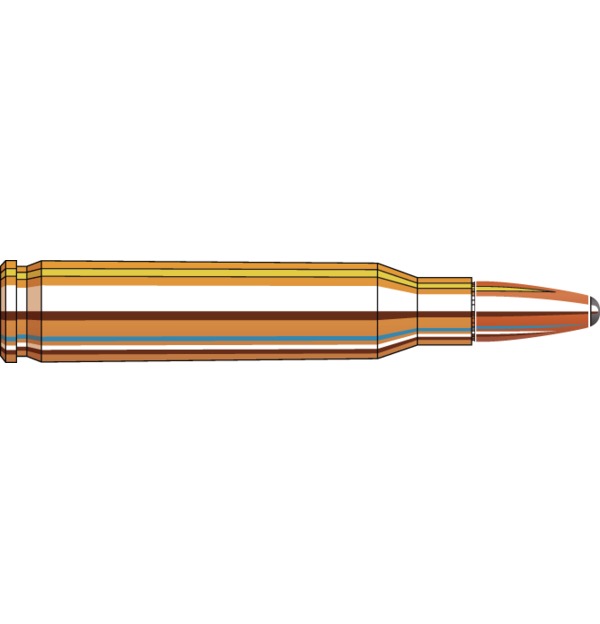
 www.hornady.com
www.hornady.com

5.56 NATO 75 gr Interlock® HD SBR™ Hornady BLACK® - Hornady Manufacturing, Inc
5.56 Nato 75 gr InterLock HD SBR Hornady Black is designed specifically for 10.5-11.5 SBR’s by using proprietary propellant technology and a bullet designed with technology from industry leading Critical Duty FlexLock bullets. This round provides exc...
To compare the two loads you’re going to want to check to what range the projectile stays above the reliable fragmentation or expansion threshold. Internet lore says that 77gr TMK’s fragmentation velocity as stated by Sierra is 1900fps though there are notes from folks that it fragments below that speed too. The 50gr TSX as loaded by Black Hills is not the same as the reloading component - expansion threshold on this one is allegedly 2500fps. Plug the data into your calculator and compare the external ballistics appropriately.
I have no personal experience, but if you can find some 70 grain Barnes TSX, I’d go with that. Did a Q&A with John McPhee, I asked him what bullet worked best over seas, he said the TSX out of an SBR was his go to and worked great. I picked up 500 rounds of 75 gr Gold Dots when PSA had them for $10.99 a box.
The 50gr TSX as loaded by Black Hills is not the same as the reloading component - expansion threshold on this one is allegedly 2500fps.
That’s dogshit
Do you want to be more specific?That’s dogshit
Do you want to be more specific?
2500fps is a shit minimum expansion velocity. Barnes also don’t expand 100% at their minimum velocity.
Myself, I would want the additional Blind Barrier capabilities of the 50gr TSX.
And given your choices I would opt for the 50gr TSX.
I decided a long time ago , at closer ranges ( inside 100yds for me ) , the 50gr TSX is very hard to beat out of a 10.5" - 12.5" barrel.
I would use the 77gr TMK for longer distances.
I would also consider some 55gr Speer GD.
And some more helpful info...
https://www.snipershide.com/shootin...acy-velocity-and-terminal-ballistics.7110384/
And given your choices I would opt for the 50gr TSX.
I decided a long time ago , at closer ranges ( inside 100yds for me ) , the 50gr TSX is very hard to beat out of a 10.5" - 12.5" barrel.
I would use the 77gr TMK for longer distances.
I would also consider some 55gr Speer GD.
And some more helpful info...
https://www.snipershide.com/shootin...acy-velocity-and-terminal-ballistics.7110384/
Last edited:
Not me and I don’t know the seller, but here’s someone selling Hornady TAP SBR https://tacswap.com/post/65355c78c1c8e65775d39a01
If the 2500fps is the expansion threshold of the 50gr TSX, that muther phucker is way too tough. For copper monos, one needs to look at Hammer Bullets. 1700-1800fps is across the board is the expansion bracket of Hammers. I can imagine less with their 50-70gr .224 offerings.To compare the two loads you’re going to want to check to what range the projectile stays above the reliable fragmentation or expansion threshold. Internet lore says that 77gr TMK’s fragmentation velocity as stated by Sierra is 1900fps though there are notes from folks that it fragments below that speed too. The 50gr TSX as loaded by Black Hills is not the same as the reloading component - expansion threshold on this one is allegedly 2500fps. Plug the data into your calculator and compare the external ballistics appropriately.
Have used the 70gr TSX for past few years out of an 11.5 SBR to kill hundreds of pigs very effectively from 10-300m. Great terminal performance. I give it a slight edge over mk262 that several of my hunting buddies use when out with me, but it also works very well. I’d go with whichever you can find cheapest in bulk.
FWIW... Barnes / BH wanted the 50gr TSX bullet tougher for windsheilds, blind barrier , etc.If the 2500fps is the expansion threshold of the 50gr TSX, that muther phucker is way too tough. For copper monos, one needs to look at Hammer Bullets. 1700-1800fps is across the board is the expansion bracket of Hammers. I can imagine less with their 50-70gr .224 offerings.
You are correct it is a tough little bullet.
From another website, here are some Barnes bullets expansion thresholds.
50 TSX 2300fps? Expansion floor
Note that the BC on this bullet is pretty low; I got it from Barnes. Also, velocity is extremely barrel length dependent.
10” 2759fps@muzzle 105yd limit
11.5” 2940fps@muzzle 140yd limit
14.5” 3250fps@muzzle 200yd limit
16” 3268fps@muzzle 205yd limit
62 TSX 1900fps expansion floor
10.5” 2654fps@muzzle 270yds limit
11.5” 2775@muzzle 300yds limit
14.5” 2939@muzzle 350yds limit
70 TSX 1800fps expansion floor
10.5” 2559fps@muzzle 290yds limit
11.5” 2649fps@muzzle 320yds limit
14.5” 2746@muzzle 355yds limit
16” 2788@muzzle 370yds limit
Thanks for everyone's thoughts. Now I'm leaning towards the 77gr TMK due to where I live and the possibility of over penetration with the 50gr TSX. I didn't take that into consideration with it being barrier blind. Also I can get a case of the 77gr TMK for $595 out the door. Where as the 50gr TSX would be $800 out the door.
I use 70 gr TSX for accurate mid to long-range HD out of 12.5" - 16". For CQB and shorter than 12.5 (11.5 is my main HD gun) I use 50 gr TSX Optimized. The 50g TSX is an excellent HD round. When I asked someone who used it overseas they said it was "just awesome, and a heart attack".
I found in my guns (1:7 twist) that the 50gr TSX was a sub 2 moa round (not really an issue for 100 and in) and the 70gr was sub moa.
I found in my guns (1:7 twist) that the 50gr TSX was a sub 2 moa round (not really an issue for 100 and in) and the 70gr was sub moa.
Last edited:
Thanks for everyone's thoughts. Now I'm leaning towards the 77gr TMK due to where I live and the possibility of over penetration with the 50gr TSX. I didn't take that into consideration with it being barrier blind. Also I can get a case of the 77gr TMK for $595 out the door. Where as the 50gr TSX would be $800 out the door.
Source? Most TMK is sold out or higher price.
Right, it is typically $1.60 - $2 a roundSource? Most TMK is sold out or higher price.
Just to be clear, the grain count only matters out of short barrels, when you are dealing with either Long range/High BC bullets OR are stuck with issue ammo.For HD using heavier bullets of a certain construction is the primary go to when using a shorter barrel. There are a ton of options considering the criteria you value the most. A 62 grain soft point is excellent, but so are an array of bullets in the 75-77 grain range.
It's not 100% about the grain, but it IS a HUGE consideration when using shorter barrels. Things like 'what is the bullet designed to do?' are also important. Something with a thick heavy jacket will need a lot more velocity to perform. On the other hand a thinner jacket 'match' bullet can aid in fragmentation.
There is no '100% right for everybody' but the 77 grain SMKs are generally the gold standard on a whole host of criteria.
You aren't getting frag out of a short barrel due to velocity. There is an argument the 77GR SMK would frag with their thin jackets, but I think it was more to due with weight retention and energy transference and less rounds just passing through wasting energy that you want on the target, not on whats behind it (m193/M885). The reason people went to heavier bullets was units downrange who had access to MK262 started using it in their MK18's and similar guns because it performed better than M885 on flesh at short range, while retaining a bit more energy at longer ranges when needed. Civies are copycats and saw them doing it so they assumed it was the best option out of their shorties.
The Marines adopted the MK318 due to similar issues with M885. If MK262 was all that, they woudn;t have solicited a new round. The MK262 sucks at barrier penetration.
For those of us not stuck with Mil issue ammo, there are MUCH better options than the 75-77gr class match bullets. We have commercial offerings of bonded/soft points designed to be shot out of a SBR/Carbine, using low flash powder that will outperform anything else.
Now as far as the 50gr TSX which is a hunting bullet, I am sure it will perform better than M885/M193 or 77gr SMK. Personally, I would go for one of the 60-64gr class bonded soft points that are issued to LE and Swat teams all over the nation. They are proven performers at putting assholes in the ground at typical shooting distances. We have autopsy reports and AAR's to prove it.
There is alot of ignorance out and BS around the 77 class bullets out of short rifles, so you probably want to touch base with someone who is knowledgeable about the subject.
Last edited:
50 grain TSX as loaded by Black Hills is not a hunting bullet.
It’s a specially modified (beefed up) bullet specifically for barrier penetration so the petals won’t shear off when penetrating difficult barriers like auto glass. It’s excellent at its intended purpose.
Because it’s beefed up to survive barriers, it needs more velocity than other TSX rounds to open. This means:
1. It’s not as good as other similar TSX rounds for hunting if the range is expected to make opening of the TSX an issue.
2. There’s nothing bad or defective about the round as some above have suggested. It’s built for a purpose and excels at that purpose. You not understanding that makes you uneducated on the subject. It doesn’t make the BH 50 grain TSX load suck.
The 77 grain TMK is NOT the same as the 77 grain SMK.
The BC is higher, but more importantly for many of us, the terminal performance is better/more consistent. I’ve taken countless big game animals with these from SBRs and the results are incredible.
If barriers are expected, the 50 TSX is one of my go to loads.
If open air shots are expected, the 77TMK is absolutely KING. What most people fail to consider, is the few (very few) bullets that compete with the 77 TMK in terminal performance ALL suck in comparison to the TMK in accuracy. So your 70 grain TSX may do similar damage at 350 yards, but my 77 TMK will actually land where I pointed it, which trumps all else.
For the OP, almost anything will do well because his intended use is close range where 99% of the projectiles on the market will open/fragment and pretty much anything will be accurate enough.
It’s a specially modified (beefed up) bullet specifically for barrier penetration so the petals won’t shear off when penetrating difficult barriers like auto glass. It’s excellent at its intended purpose.
Because it’s beefed up to survive barriers, it needs more velocity than other TSX rounds to open. This means:
1. It’s not as good as other similar TSX rounds for hunting if the range is expected to make opening of the TSX an issue.
2. There’s nothing bad or defective about the round as some above have suggested. It’s built for a purpose and excels at that purpose. You not understanding that makes you uneducated on the subject. It doesn’t make the BH 50 grain TSX load suck.
The 77 grain TMK is NOT the same as the 77 grain SMK.
The BC is higher, but more importantly for many of us, the terminal performance is better/more consistent. I’ve taken countless big game animals with these from SBRs and the results are incredible.
If barriers are expected, the 50 TSX is one of my go to loads.
If open air shots are expected, the 77TMK is absolutely KING. What most people fail to consider, is the few (very few) bullets that compete with the 77 TMK in terminal performance ALL suck in comparison to the TMK in accuracy. So your 70 grain TSX may do similar damage at 350 yards, but my 77 TMK will actually land where I pointed it, which trumps all else.
For the OP, almost anything will do well because his intended use is close range where 99% of the projectiles on the market will open/fragment and pretty much anything will be accurate enough.
You shooting the TMK mag length in AR? I saw reports of guys getting less precision due to the ogive being farther back than the SMK.50 grain TSX as loaded by Black Hills is not a hunting bullet.
It’s a specially modified (beefed up) bullet specifically for barrier penetration so the petals won’t shear off when penetrating difficult barriers like auto glass. It’s excellent at its intended purpose.
Because it’s beefed up to survive barriers, it needs more velocity than other TSX rounds to open. This means:
1. It’s not as good as other similar TSX rounds for hunting if the range is expected to make opening of the TSX an issue.
2. There’s nothing bad or defective about the round as some above have suggested. It’s built for a purpose and excels at that purpose. You not understanding that makes you uneducated on the subject. It doesn’t make the BH 50 grain TSX load suck.
The 77 grain TMK is NOT the same as the 77 grain SMK.
The BC is higher, but more importantly for many of us, the terminal performance is better/more consistent. I’ve taken countless big game animals with these from SBRs and the results are incredible.
If barriers are expected, the 50 TSX is one of my go to loads.
If open air shots are expected, the 77TMK is absolutely KING. What most people fail to consider, is the few (very few) bullets that compete with the 77 TMK in terminal performance ALL suck in comparison to the TMK in accuracy. So your 70 grain TSX may do similar damage at 350 yards, but my 77 TMK will actually land where I pointed it, which trumps all else.
For the OP, almost anything will do well because his intended use is close range where 99% of the projectiles on the market will open/fragment and pretty much anything will be accurate enough.
Are you loading this ammo or is it factory? In factory loads, with my guns (all gas guns), I have seen batter accuracy out of 70gr tsx loaded by Barnes vs some of the offerings I have tried that are TMKs.50 grain TSX as loaded by Black Hills is not a hunting bullet.
It’s a specially modified (beefed up) bullet specifically for barrier penetration so the petals won’t shear off when penetrating difficult barriers like auto glass. It’s excellent at its intended purpose.
Because it’s beefed up to survive barriers, it needs more velocity than other TSX rounds to open. This means:
1. It’s not as good as other similar TSX rounds for hunting if the range is expected to make opening of the TSX an issue.
2. There’s nothing bad or defective about the round as some above have suggested. It’s built for a purpose and excels at that purpose. You not understanding that makes you uneducated on the subject. It doesn’t make the BH 50 grain TSX load suck.
The 77 grain TMK is NOT the same as the 77 grain SMK.
The BC is higher, but more importantly for many of us, the terminal performance is better/more consistent. I’ve taken countless big game animals with these from SBRs and the results are incredible.
If barriers are expected, the 50 TSX is one of my go to loads.
If open air shots are expected, the 77TMK is absolutely KING. What most people fail to consider, is the few (very few) bullets that compete with the 77 TMK in terminal performance ALL suck in comparison to the TMK in accuracy. So your 70 grain TSX may do similar damage at 350 yards, but my 77 TMK will actually land where I pointed it, which trumps all else.
For the OP, almost anything will do well because his intended use is close range where 99% of the projectiles on the market will open/fragment and pretty much anything will be accurate enough.
BH 50gr TSX is arguably the best civilian 5.56 load for barrier penetration against threats inside cars.
The 77gr TMK is arguably the best civilian 5.56 load for soft tissue damage without barriers.
LE may encounter threats in vehicles relatively often, but that is a very unlikely threat in a home defense application.
Also, 62gr TSX and 70gr TSX perform nearly as well against auto glass, but are easier to find, cheaper, and will reliably expand out to farther distances than BH 50gr TSX. Honestly, I feel like BH 50gr TSX is a very niche load and civilians would be better suited by 62/70gr TSX if you’re wanting barrier blind loads.
Personally, I just load 77gr TMK. It has a ridiculous range of good terminal ballistics from an SBR if the need should ever come up and should stop threats against my family at home very quickly with minimal risk from over-penetration of the threat’s body. Some mention not being precise, yeah it’s no 69gr SMK, but my barrels generally shoot it in the 3/4 MOA - 1 1/2 MOA range as a realistic estimate. That’s good enough for the CONOPs of close to mid range.
The 77gr TMK is arguably the best civilian 5.56 load for soft tissue damage without barriers.
LE may encounter threats in vehicles relatively often, but that is a very unlikely threat in a home defense application.
Also, 62gr TSX and 70gr TSX perform nearly as well against auto glass, but are easier to find, cheaper, and will reliably expand out to farther distances than BH 50gr TSX. Honestly, I feel like BH 50gr TSX is a very niche load and civilians would be better suited by 62/70gr TSX if you’re wanting barrier blind loads.
Personally, I just load 77gr TMK. It has a ridiculous range of good terminal ballistics from an SBR if the need should ever come up and should stop threats against my family at home very quickly with minimal risk from over-penetration of the threat’s body. Some mention not being precise, yeah it’s no 69gr SMK, but my barrels generally shoot it in the 3/4 MOA - 1 1/2 MOA range as a realistic estimate. That’s good enough for the CONOPs of close to mid range.
Last edited:
You shooting the TMK mag length in AR? I saw reports of guys getting less precision due to the ogive being farther back than the SMK.
Are you loading this ammo or is it factory? In factory loads, with my guns (all gas guns), I have seen batter accuracy out of 70gr tsx loaded by Barnes vs some of the offerings I have tried that are TMKs.
Factory Black Hills 5.56mm
My local gun store has a case of each for that price. I'm headed over there in the AM to grab the case of TMK. Also a place online called AE Ammo has the TMK in stock for $1.37/rd with free shipping.Source? Most TMK is sold out or higher price.
They all over penetrate, some more than others. Here is a decent vid to start your research with. I use a 53 and 40 gr vmax in my 10.3 and 11.5.
this vid is not anything scientific, just something to think about.
this vid is not anything scientific, just something to think about.
They all over penetrate, some more than others. Here is a decent vid to start your research with. I use a 53 and 40 gr vmax in my 10.3 and 11.5.
this vid is not anything scientific, just something to think about.
“Over-penetrating” doesn’t mean going through drywall. It means going through your meat-sack target and still being lethal on the other side.
All worthwhile self defense cartridges are going to penetrate through drywall.
My 12.5 gets mk262's for shtf/hunting/long(er) range shooting.
My 11.5 gets the hornady black 75gr interloks. I've shot it with the can and have found their claims about the powder charge being super suppressor friendly to be true
Great ballistics
Great barrier performance
Great accuracy
You pick two. I wish there was an option that actually had all 3
On a side note the federal fusions msr loading (62gr I think) shot about 1.8 moa out of my buddies 11.5 and I think the expansion range was out to about 300-350. They have solid terminal ballistics and may be a good all around compromise if you need performance against intermediate barriers
My 11.5 gets the hornady black 75gr interloks. I've shot it with the can and have found their claims about the powder charge being super suppressor friendly to be true
Great ballistics
Great barrier performance
Great accuracy
You pick two. I wish there was an option that actually had all 3
On a side note the federal fusions msr loading (62gr I think) shot about 1.8 moa out of my buddies 11.5 and I think the expansion range was out to about 300-350. They have solid terminal ballistics and may be a good all around compromise if you need performance against intermediate barriers
They all over penetrate, some more than others. Here is a decent vid to start your research with. I use a 53 and 40 gr vmax in my 10.3 and 11.5.
this vid is not anything scientific, just something to think about.
FLAT OUT FALSE.
Are you loading this ammo or is it factory? In factory loads, with my guns (all gas guns), I have seen batter accuracy out of 70gr tsx loaded by Barnes vs some of the offerings I have tried that are TMKs.
I've loaded a few hundred of the 77TMK's to mag length(magpul 20rd'ers) and they've performed great in my 18" lothar walther and a 16" carbine, which I no longer have. I actually ended up loading to 2.25" as that seemed to perform the best at 300yds.
I did maybe 15x 5rd groups from 100-300 and every one was sub-moa. If I did my part, they were 0.5-0.7moa but I think they averaged about 3/4 moa across the groups. I ran them pretty hot for a while with TAC and was getting 2800fps out of my 18".
Settled back on XBR 8208. I've been using the Hornady 75gr HPBT now though, as they're cheaper...but idk, I might end up going back to the TMK
Another bullet to look at is the Maker 50gr High Velocity Rex and 50gr HV T-Rex:
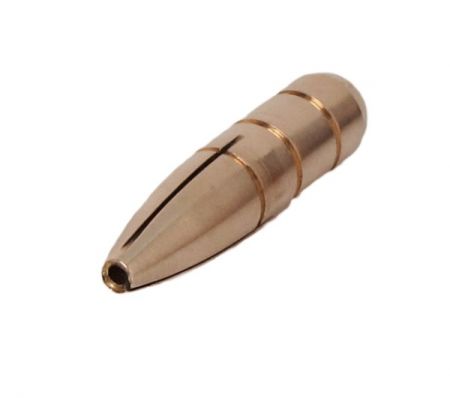

These will do 3200-3300fps from a 20” at 5.56 pressures. They’re really soft with a lower expansion threshold than most of the monoliths on the market.
12.5”: 2940-3040fps
11.5”: 2890-2990fps
10.3”: 2800-2900fps


These will do 3200-3300fps from a 20” at 5.56 pressures. They’re really soft with a lower expansion threshold than most of the monoliths on the market.
12.5”: 2940-3040fps
11.5”: 2890-2990fps
10.3”: 2800-2900fps
Completely agree. I think the best overall compromise round is the Speer gold dot 62 gr/federal fusion 62 gr, which are basically the same thing. I personally keep Speer gold dot 62 grain loaded as my "social purposes" round.My 12.5 gets mk262's for shtf/hunting/long(er) range shooting.
My 11.5 gets the hornady black 75gr interloks. I've shot it with the can and have found their claims about the powder charge being super suppressor friendly to be true
Great ballistics
Great barrier performance
Great accuracy
You pick two. I wish there was an option that actually had all 3
On a side note the federal fusions msr loading (62gr I think) shot about 1.8 moa out of my buddies 11.5 and I think the expansion range was out to about 300-350. They have solid terminal ballistics and may be a good all around compromise if you need performance against intermediate barriers
Those would be my choice if my 12.5 didn't shoot mk262's so well. I can confidently engage from 0-800 at the expense of barrier performanceCompletely agree. I think the best overall compromise round is the Speer gold dot 62 gr/federal fusion 62 gr, which are basically the same thing. I personally keep Speer gold dot 62 grain loaded as my "social purposes" round.
I've actually shot some 69tmk's through my 12.5 which grouped even better. I put some through gel and the slower velocities 2720ish) actually got me 15ish" of penetration with stupid good ballistics. But it's unobtainium so 262's it is...
Tmks under-penetrate with high velocities fwiw
So I've been shooting Black Hills 77gr OTM out of my 10.3 and 12.5. But I'm thinking of switching over to either the 50gr TSX or 77gr TMK. This is for HD and I stumbled across some articles by Molon and it got me to thinking the 50gr might be an upgrade over the 77gr OTM i have now. But the 77gr TMK seems to be better than the 77gr OTM. That's why I included it also. Any insight would be appreciated.
You have to decide if you want a fragmenting round or a blind to barriers round (or get both!). The Sierra 77 grain Tipped MatchKing has one of the best ballistic coefficients of any 0.224" projectiles loadable to magazine length in an AR-15 and it's also extremely accurate, though often it's a tad less accurate than the the legacy Sierra 77 grain MatchKing.
The 10-shot group pictured below was fired prone off a bipod from one of my AR-15s that has a well used (but not abused) Lothar Walther barrel with a 223 Wylde chamber and a 1:8" twist using a hand-load topped with the legacy 77 grain MatchKing. The group has an extreme spread of 0.54 MOA.
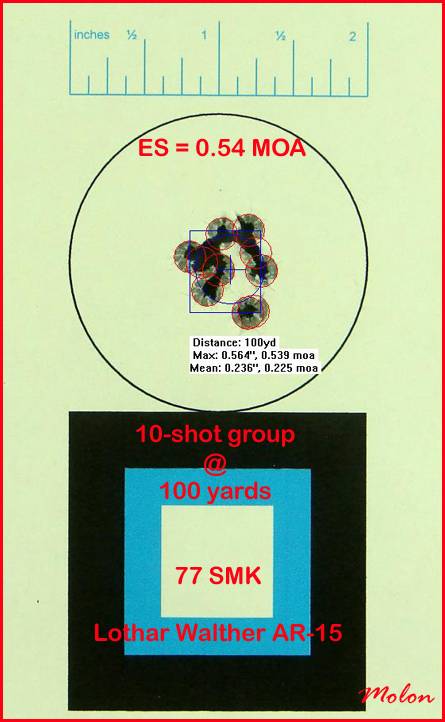
The next 10-shot group was fired using a handload topped with the 77 grain Tipped MatchKing. The group was fired off the bench from the same Lothar Walther barreled AR-15. The group has an extreme spread of 0.68".
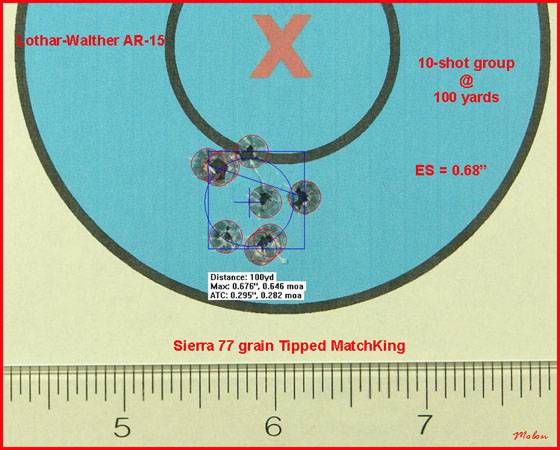
The 2023 production lots of the factory loaded Black Hills 5.56mm 77 grain Tipped MatchKing ammunition are the most accurate lots of this ammunition that I've tested.
Black Hills 5.56mm 77 Grain Tipped MatchKing Accuracy Evaluation Update

In 2016 I posted an in-depth review of the Black Hills 5.56 77 grain Tipped MatchKing ammunition. Three 10-shot groups of that 2016 lot had an average extreme spread of 1.26”. The smallest of those groups had an extreme spread of 1.14” with a mean radius of 0.39”.
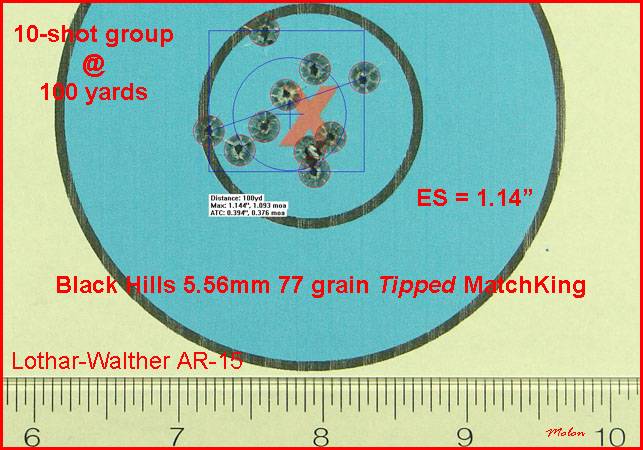
The cartridge overall length for the 2016 lot of the Black Hills 77 grain Tipped MatchKing averaged 2.246”, while a 2023 lot averaged 2.243”. The length of the bullet itself is basically the same for both lots. The 2016 lot was loaded in Winchester brass and the 2023 lot is loaded in Lake City brass with stab primer crimps. Both lots have sealant in the primer pockets and neither lot has sealant at the case mouth.

In my 2016 review, I noted that the 77 grain Tipped MatchKing was one of the longest bullets being commercially loaded to magazine length in the 5.56mm cartridge and that it had such a long ogive that the cannelure extended past the bearing surface of the bullet and onto the ogive, giving the grooves of the cannelure a rather unique “arrowhead” appearance.
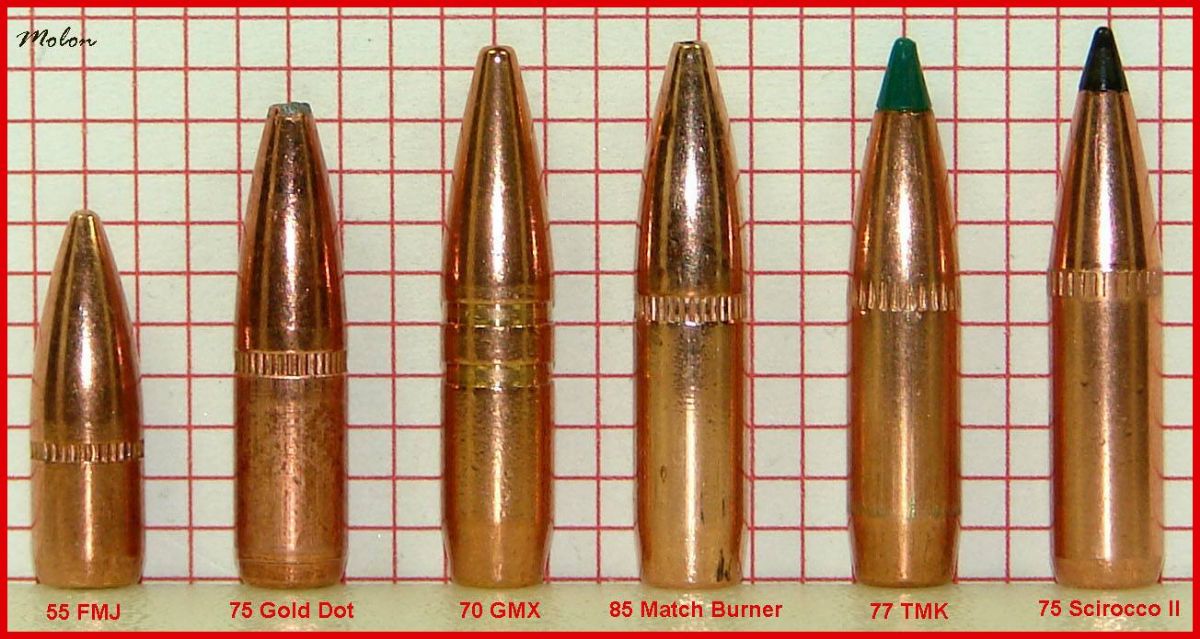

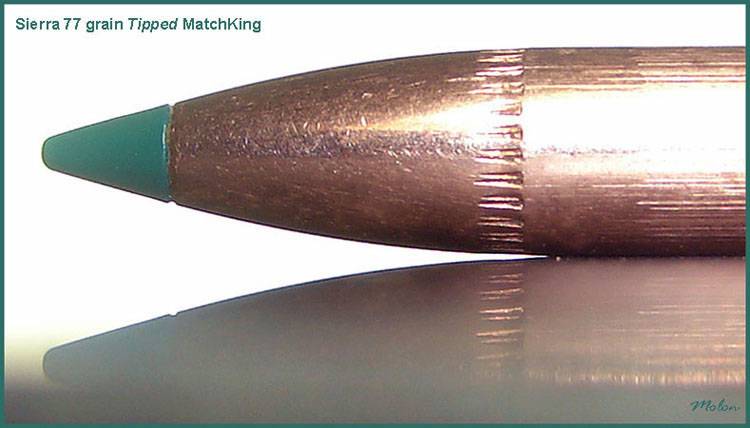
The base to ogive measurement of the bullets in the 2023 lot is approximately 0.017” longer than the 2016 lot and the configuration of the bullet at the junction of the bearing surface and the ogive now allows for a full-fledged cannelure that does not appear to extend into the ogive, or it was just a matter of pressing the cannelure deeper that makes it appear so.
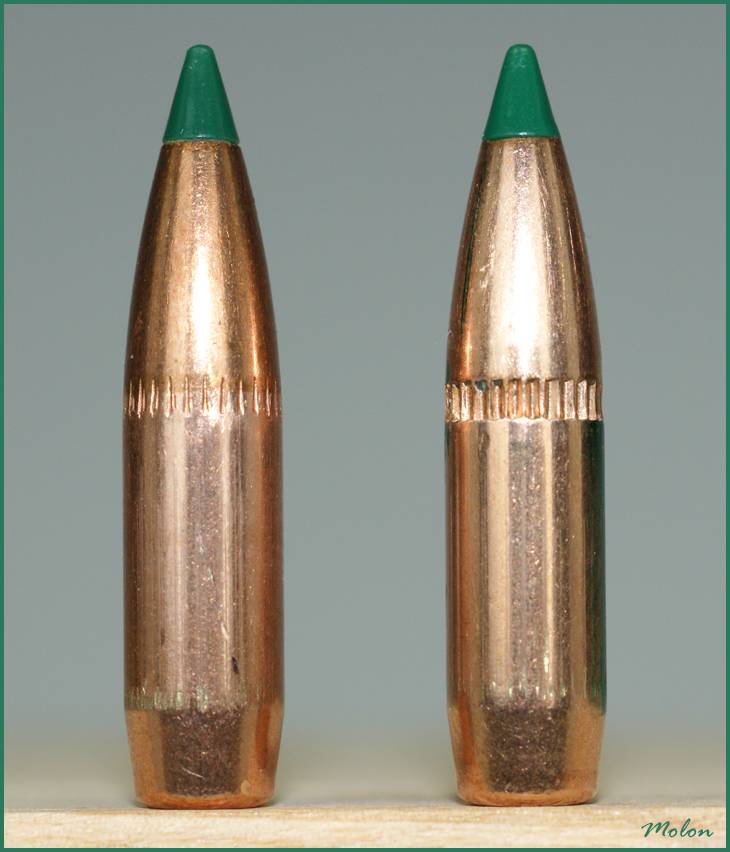
A 10-shot group of the 2023 lot of the Black Hills 5.56mm 77 grain Tipped MatchKing ammunition fired from the same Lothar Walther barreled AR-15 used to test the 2016 lot, fired under the same conditions from a distance of 100 yards had an extreme spread of 0.86” and a mean radius of 0.24”.
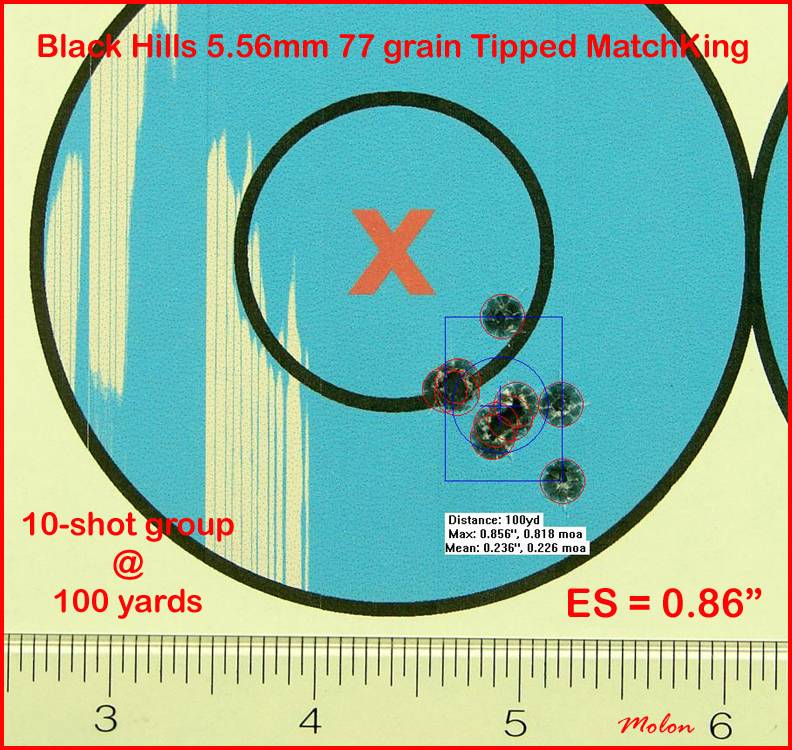
I chronographed two different lots of the 2023 Black Hills 5.56mm 77 grain Tipped MatchKing ammunition from an AR-15 with a chrome-lined, NATO chambered, 20” Colt barrel with a 1:7” twist.

The muzzle velocity that I obtained from the 2016 lot of this ammunition is shown in the table below. Black Hills now advertises that this load has a velocity of 2750 FPS from a 20” test barrel.
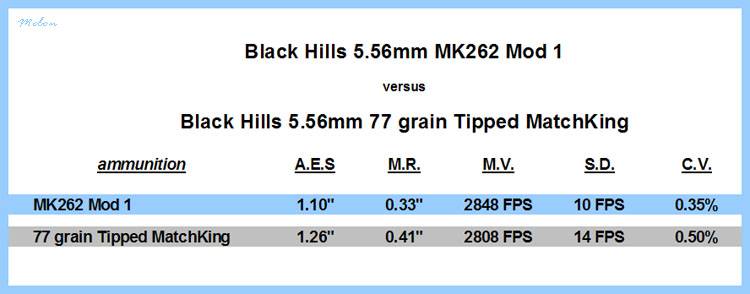
Chronographing was conducted using an Oehler 35-P chronograph with “proof screen” technology. The Oehler 35P chronograph is actually two chronographs in one package that takes two separate chronograph readings for each shot (primary velocity and proof velocity) and then compares those readings to a statistical table to determine if there is any significant difference between the two readings to determine if the primary velocity is a valid reading or likely to be an erroneous reading. If there is an erroneous reading, the chronograph “flags” the shot to let you know that shot is invalid. There were no invalid shots flagged during this testing.
The velocity stated below is the muzzle velocity as calculated from the instrumental velocity using Oehler’s Ballistic Explorer software program. The string of fire consisted of 10 rounds over the chronograph.
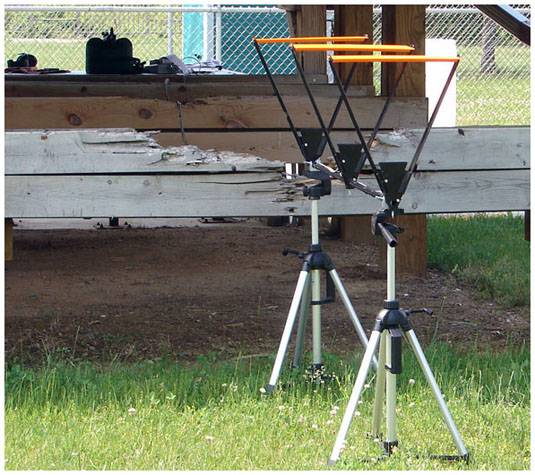

Each round was single-loaded and cycled into the chamber from a magazine fitted with a single-load follower. The bolt locked-back after each shot allowing the chamber to cool in between each shot. This technique was used to mitigate the possible influence of “chamber-soak” on velocity data. Each new shot was fired in a consistent manner after hitting the bolt release. Atmospheric conditions were monitored and recorded using a Kestrel 4000 Pocket Weather Tracker.

Atmospheric conditions
Temperature: 71 degrees F
Humidity: 42.5%
Barometric pressure: 30.05 inches of Hg
Elevation: 950 feet above sea level
The muzzle velocity for lot #703 was 2779 FPS with a standard deviation of 16 FPS. This lot had a coefficient of variation of 0.58%.
The muzzle velocity for lot #723 was 2762 FPS with a standard deviation of 21 FPS and a coefficient of variation of 0.76%.
For those of you who might not be familiar with the coefficient of variation (CV), it is the standard deviation, divided by the mean (average) muzzle velocity and then multiplied by 100 and expressed as a percentage. It allows for the comparison of the uniformity of velocity between loads with different muzzle velocities.
For comparison, the mil-spec for M193 allows for a coefficient of variation of approximately 1.2%, while one of my best 77 grain OTM hand-loads, with a muzzle velocity of 2639 PFS and a standard deviation of 4 FPS, has a coefficient of variation of 0.15%.
….
Last edited:
From an after action review, I know a 64gr Win Power Point from a 10.5" will pass through an interior wall, through an exterior wall 12ft away, travel 75yds, pass though a double pane window of another house, and embed into an interior corner of a wall. (Both stick built, dry wall, R19-21 insulation) So, don't use this round or any as tough if there is an over penetration concern. I'll stand by my 55gr frangible/Vmax recommendation if all I was intending the round to be is HD.
Yes, I understand that. But you are responsible for every round sent, and missed rounds need to be considered in HD.“Over-penetrating” doesn’t mean going through drywall. It means going through your meat-sack target and still being lethal on the other side.
All worthwhile self defense cartridges are going to penetrate through drywall.
What’s false?FLAT OUT FALSE.
From an after action review, I know a 64gr Win Power Point from a 10.5" will pass through an interior wall, through an exterior wall 12ft away, travel 75yds, pass though a double pane window of another house, and embed into an interior corner of a wall. (Both stick built, dry wall, R19-21 insulation) So, don't use this round or any as tough if there is an over penetration concern. I'll stand by my 55gr frangible/Vmax recommendation if all I was intending the round to be is HD.
Tangential question: How were your ears after that? Short term (day?) reduction in hearing? Temporary or permanent tinnitus?
Considering a 10.5” bullpup for HD, but can’t get silencers.
Okay, sure. Bottom line, don’t miss your target and know what’s behind your target in the chance that you do miss.Yes, I understand that. But you are responsible for every round sent, and missed rounds need to be considered in HD.
But that doesn’t change the fact that you’re using the term “over-penetrate” incorrectly.
Any cartridge/bullet combo that is going to have effective wounding effects is still going to penetrate through walls and pose a hazard to someone else if you miss your target. Best to identify defensible positions in your home where you can protect your family/self and have a firing lane with no known risks behind it.
I didn't fire the round. However, any gun and length barrel fired indoors, without a can, is gonna suck on the ears.Tangential question: How were your ears after that? Short term (day?) reduction in hearing? Temporary or permanent tinnitus?
Considering a 10.5” bullpup for HD, but can’t get silencers.
Stating that every round over penetrates anyway. 100% incorrect and irresponsible statements. You should never ever give anyone suggestions on defensive ammo, barrier, and terminal ballistics ever again.What’s false?
The 64 grsin Gold Dot is excellent as is the Trophy Bonded Bar Claw.
The 62 grain/64 grain Gold Dots are excellent loads for duty/self-defense. The terminal ballistic properties of these projectiles approaches that of the 62 grain Trophy Bonded Bear Claw and the Gold Dots are far more consistently accurate/precise than the 62 grain TBBC.
When hand-loaded, the 62 grain Gold Dot is the most accurate bonded-soft point that I've tested and the factory loaded ammunition is some of the most accurate factory loaded bonded soft-points that I've tested. As mentioned by another member, the bullet used in the 62 grain Gold Dot load is the same bullet found in Federal's 62 grain Fusion and Fusion MSR loads.
10-shot group of hand-loaded 62 grain Gold Dot . . .
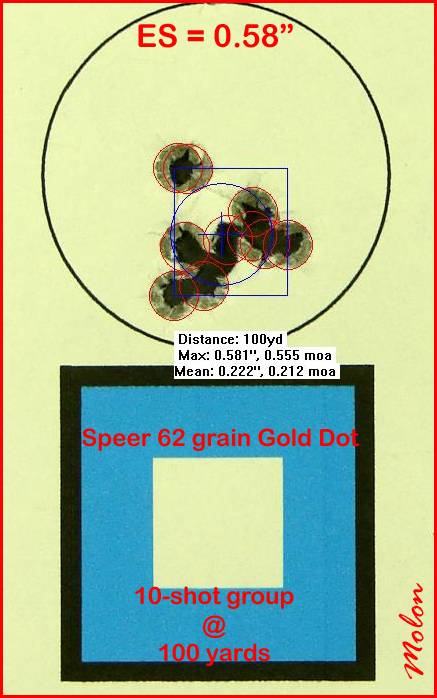
Speer LE 64 Grain Gold Dot: Velocity, Accuracy and Terminal Ballistics
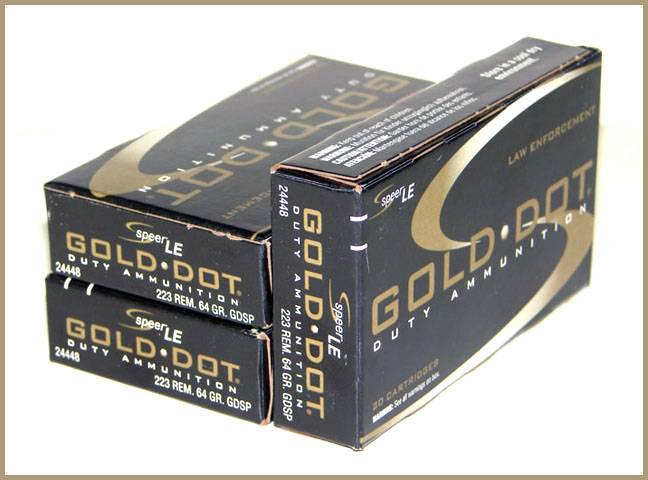
Speer has expanded its line of Gold Dot ammunition to include rifle ammunition in 223 Remington. The ammunition examined for this post is loaded with a 64 grain bonded soft point bullet that has less exposed lead at the meplat than Federal’s 62 grain Trophy Bonded Bear Claw bullet that is used in their LE223T2 load.
The 64 grain Gold Dot bullet has a boat-tail and a cannelure. This load is charged with a ball powder that according to Speer is a “flash suppressed propellant.” The primers are sealed and crimped in place, however, there is no sealant at the case mouth.
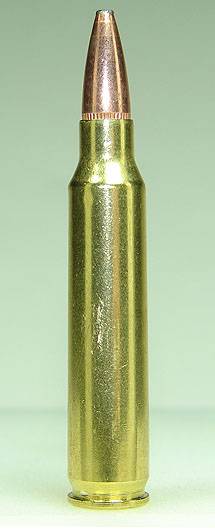
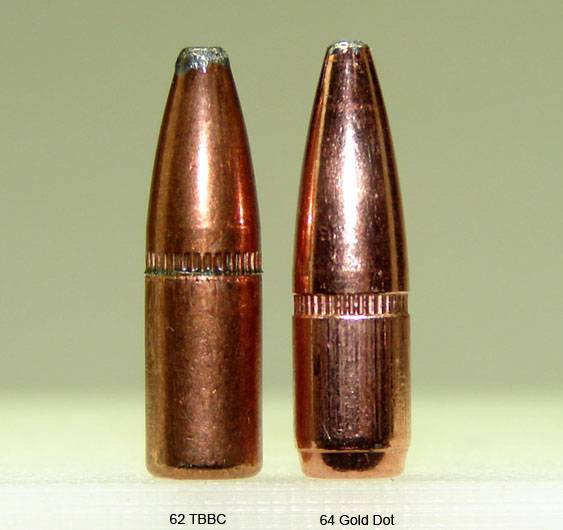
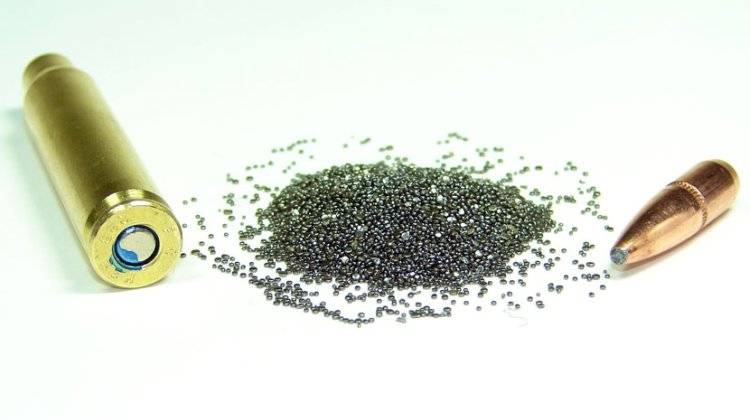
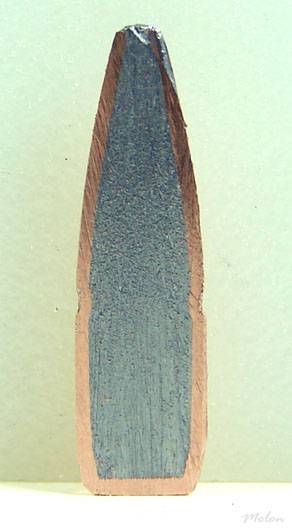
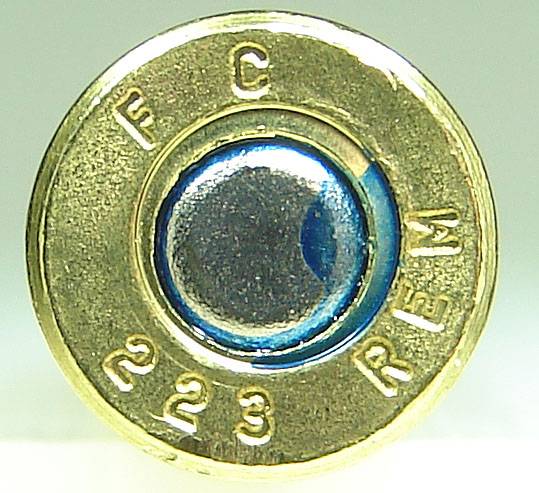
The 64 grain Gold Dot bullet has a nominal length of 0.825” and a specific gravity of 10.0. A barrel with a 1:9” twist should stabilize it quite well.
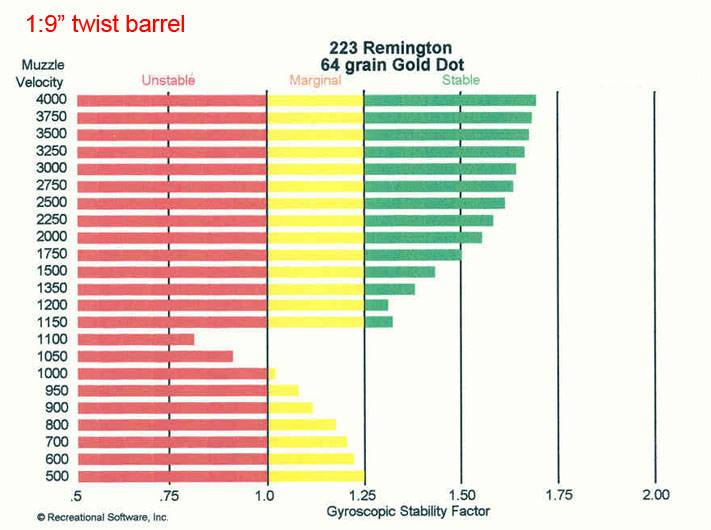
From ATK’s website:
“Like their handgun counterparts, the Gold Dot rifle bullets are constructed using Gold Dot technology. The process of joining the jacket and core one molecule at a time eliminates the potential for the leading cause of bullet failure—jacket/core separation. It also ensures impressive weight retention through barriers as tough as auto-glass.”
Manufacturers typically use bolt-action “test barrels” to obtain their advertised velocities for their ammunition. These test barrels are usually 24” long and often have minimum spec SAAMI chambers. These factors combine to give ammunition higher advertised velocities than the velocities that we actually obtain from our AR-15s. Also, due to its gas operating system, the AR-15 looses 20 fps or more of velocity compared to an equivalent barrel without a gas system.
Sierra test barrels
Shooting Times 2009
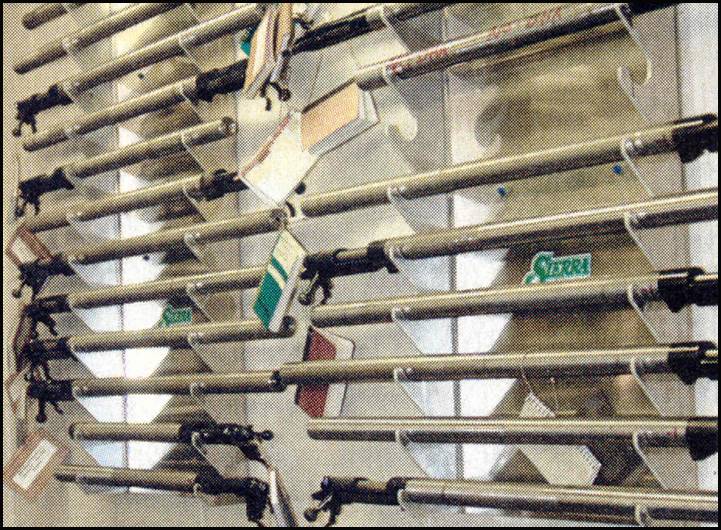
The 64 grain Gold Dot load was chronographed from a 20” Colt M16A2 barrel, a 16” Colt light-weight barrel and a 14.5” Colt M4A1 barrel. All of the barrels have chrome lining, NATO chambers and 1:7” twists. 10-shot strings of the load were fired over an Oehler 35-P chronograph with “proof screen” technology. All velocities listed are muzzle velocities as calculated from the instrumental velocities using Oehler’s Ballistic Explorer software program.
Each round was single-loaded and cycled into the chamber from a magazine fitted with a single-load follower. The bolt locked-back after each shot allowing the chamber to cool in between each shot. This technique was used to mitigate the possible influence of “chamber-soak” on velocity data. Each new shot was fired in a consistent manner after hitting the bolt release. Atmospheric conditions were monitored and recorded using a Kestrel 4000 Pocket Weather Tracker.
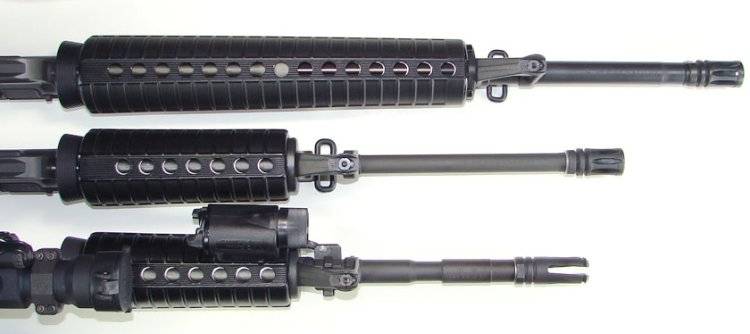
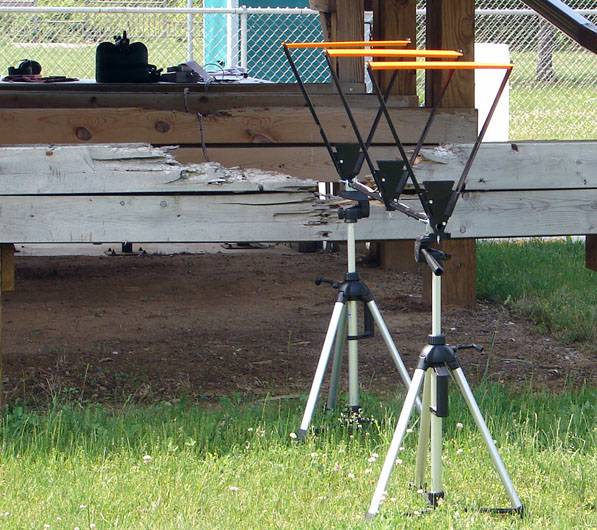
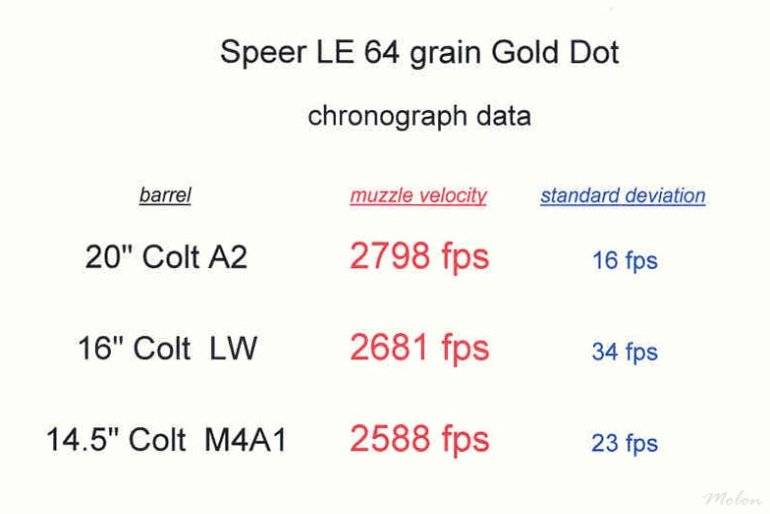
Accuracy testing was conducted following my usual protocol of firing 10-shot groups from a concrete bench at a distance of 100 yards using my 24” Krieger barreled AR-15. This barrel has a 1:7.7” twist. The free-float rail of the rifle rested in a Sinclair Windage Benchrest and the PRS stock was stabilized in a Protektor bunny-ear rear bag. Wind conditions were monitored using a Wind Probe. Sighting was performed using a Leupold Competition Series scope with a mirage shade. The scope was adjusted to be parallax free at 100 yards.
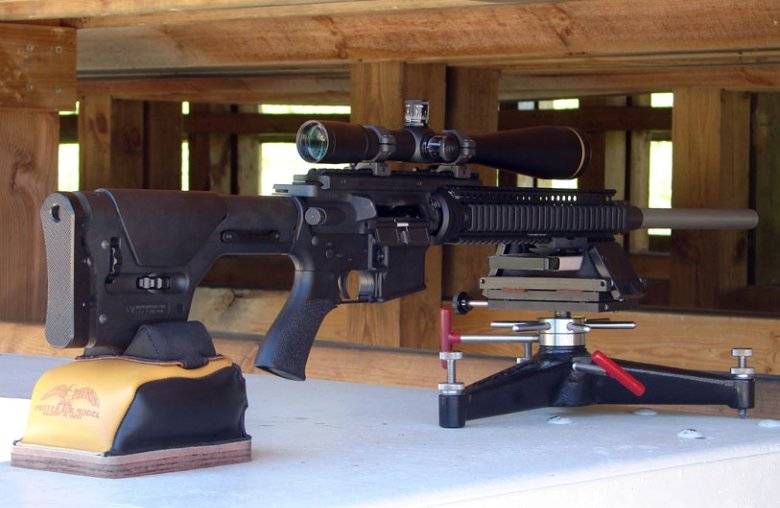
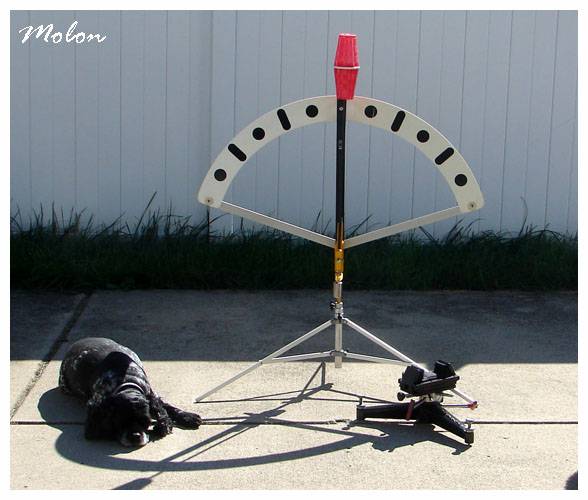
Prior to testing the 64 grain Gold Dot load, I fired a 10-shot control group using hand-loaded 69 grain Sierra MatchKings. That group had an extreme spread of 0.86”. Three 10-shot groups of the Speer LE 64 grain Gold Dots fired in a row had extreme spreads that measured:
1.11”
0.91”
1.30”
for a 10-shot average extreme spread of 1.12”! I over-layed those three groups on each other using RSI Shooting Lab to form a 30-shot composite group. The composite group had a mean radius of 0.33”.
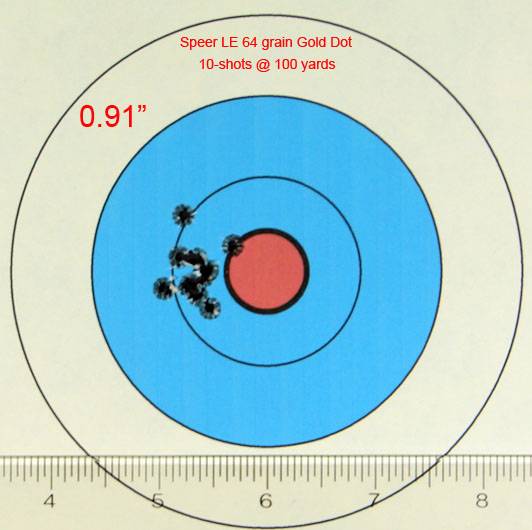
For comparison, previous testing of the Black Hills blue box 75 grain MHP load fired from the same set-up as above produced three 10-shot groups at 100 yards that had an average extreme spread of 1.14” and a mean radius of 0.37” for the 30-shot composite group.
Terminal Ballistic Properties of the 64 grain Gold Dot
Thanks to the efforts of Dr. G.K. Roberts, we now have some excellent answers to the questions of terminal ballistics pertaining to the Speer 64 grain Gold Dot LE load. The results shown below indicate the penetration of this load in bare ballistic gelatin as well as after having passed through auto-glass. Auto (safety) glass is one of the most difficult barriers (of those commonly tested) for 5.56mm/.223 Remington loads to penetrate and still perform adequately in ballistic gelatin.


Comparisons.
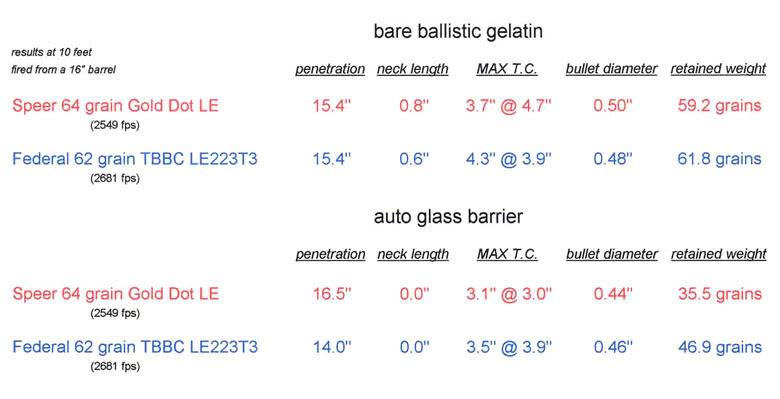
….
Federal 62 Grain Fusion vs Federal 62 Grain Fusion MSR vs Speer LE 62 Grain Gold Dot[/size=6]
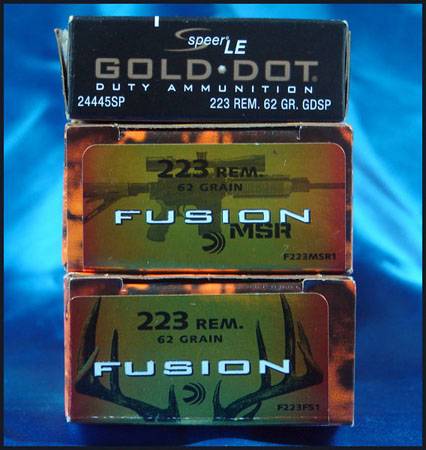
The muzzle velocities shown in the tables below were obtained back-to-back during the same chronograph session using recent lots of all three of the Fusion/Gold Dot loads chrongographed.
Atmospheric Conditions
Temperature: 73 degrees F (plus or minus one degree)
Barometric Pressure: 29.68 inches of Hg
Humidity: 62%
Altitude: 950 feet above sea level
Muzzle velocities from a 20” Colt M16A2 barrel with a NATO chamber, chrome lining and a 1:7” twist.
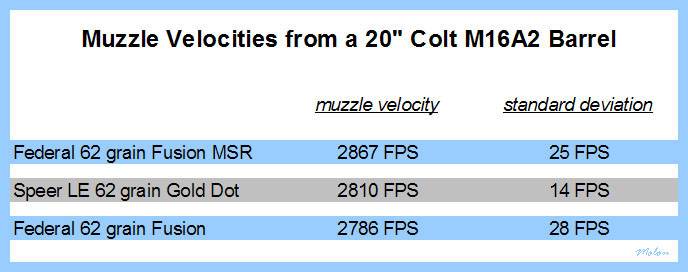
Muzzle velocities from a 14.5 Noveske N4 light barrel with a NATO chamber, chrome lining and a 1:7’ twist.
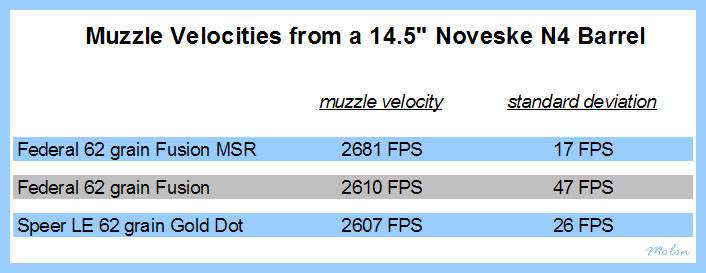
10-shot groups were fired from one of my precision AR-15s with a Lothar-Walther barrel with a 223 Wylde chamber and a 1:8” twist. The groups were fired from the bench at a distance of 100 yards with the same sight settings on the scope for each of the three groups.
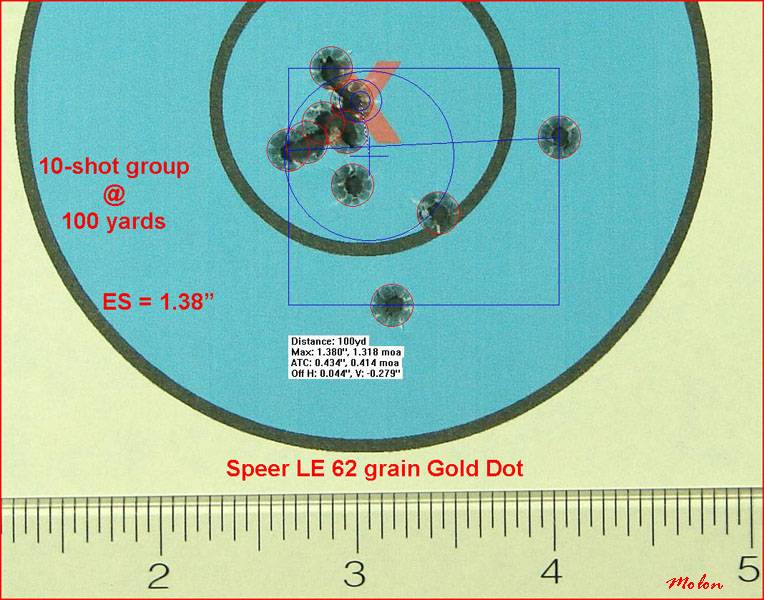
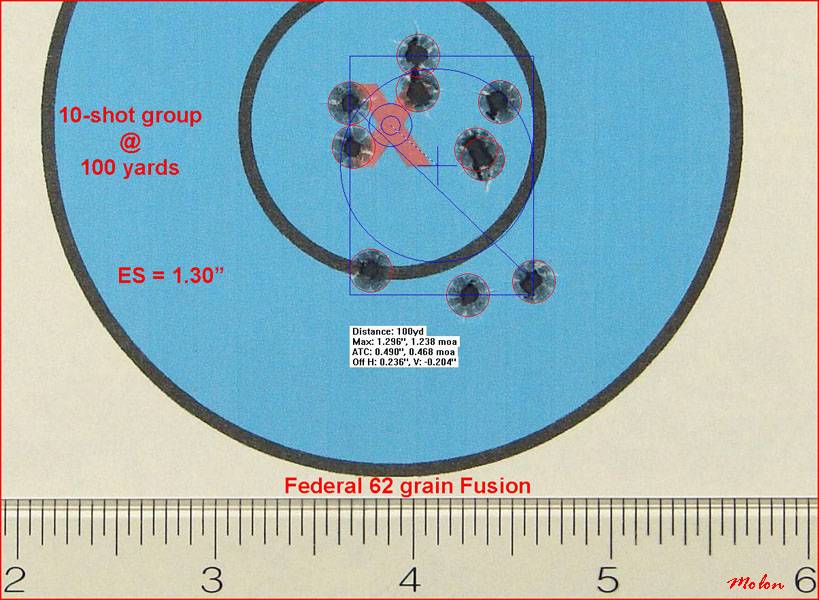
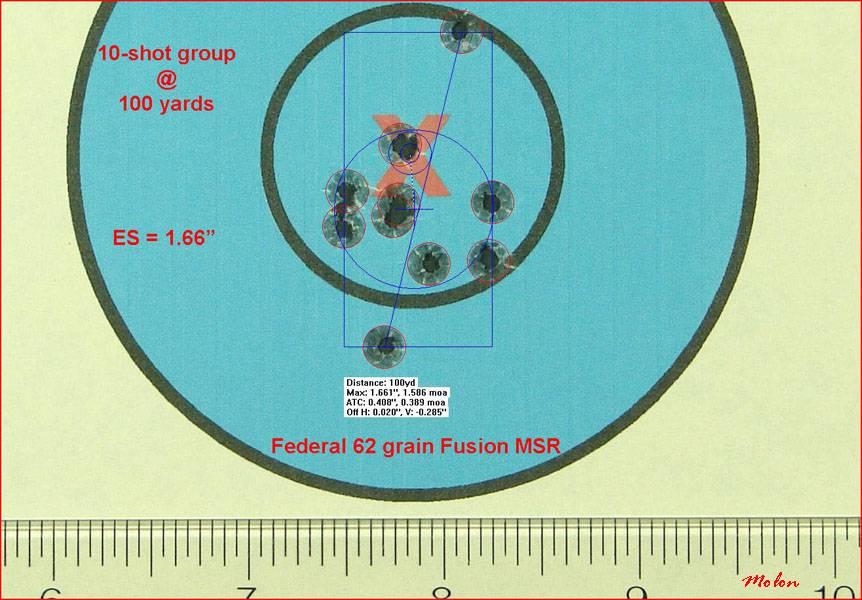
....
I appreciate your data but you literally come in and vomit on threads
I appreciate your data but you literally come in and vomit on threads
I'm so sorry that posting technical data in a technical thread in a technical forum hurts your delicate little feelings. Try taking an extra dose of your Ritalin and focusing for the two whole minutes that it takes to view my articles, or if that's just too much for you to bear, just scroll past my posts.
...
Last edited:
Could care less about feelings. Scrolling for 2 minutes to get past all the bullshit pictures, including your dog is the part that hurts.
77gr TMK 0.5 MOA Black Hills Factory loads would be superior to MK262 MOD 0 & 1 in my opinion.
Would open up at what...300-400meters from a 14.5-16"?
Probably. More then OTMs.
All depends on what your objective is. As noted before, the legacy 77 grain MathKings tend to be a hair more accurate at medium distances, but as others have mentioned, the 77 grain Tipped MatchKing has better terminal ballistic properties than the legacy 77 grain MatchKing.

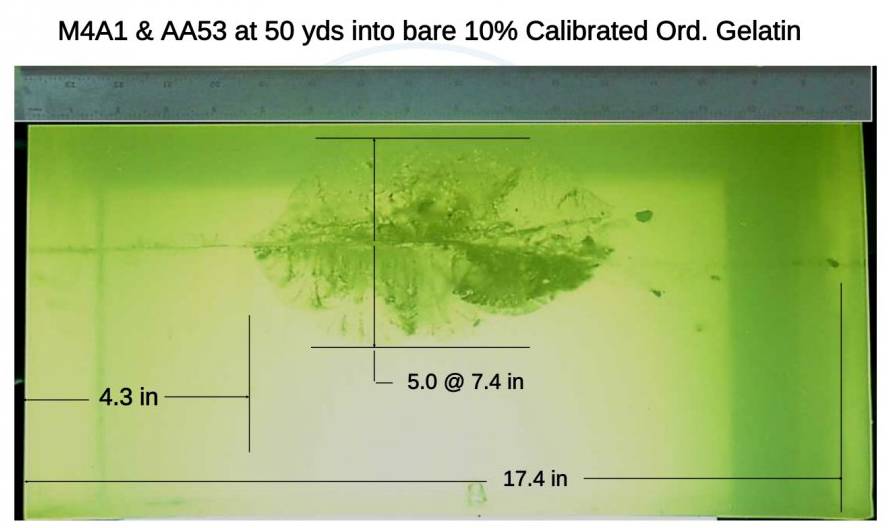
....
Last edited:
Similar threads
- Replies
- 3
- Views
- 137
- Replies
- 3
- Views
- 538
